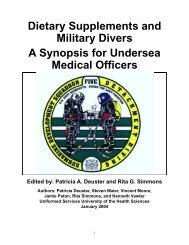Force Health Protection: Nutrition and Exercise Resource Manual
Force Health Protection: Nutrition and Exercise Resource Manual
Force Health Protection: Nutrition and Exercise Resource Manual
You also want an ePaper? Increase the reach of your titles
YUMPU automatically turns print PDFs into web optimized ePapers that Google loves.
Worksheet 5-1. Determine Your Target Heart Rate<br />
Age-Predicted Max HR = 220 - your age = bpm.<br />
60% max HR = max HR x 0.60 = bpm.<br />
90% max HR = max HR x 0.90 = bpm.<br />
Target HR Zone = to bpm.<br />
See “Training Design <strong>and</strong> Progression” on page 43 to<br />
determine what heart rates, within this range, you should aim<br />
for during exercise based on your level of physical fitness <strong>and</strong><br />
your fitness goals.<br />
Calories<br />
The term “Calorie” is very familiar to most people <strong>and</strong> is often used to<br />
gauge exercise intensity. Calories per hour is the amount of energy an<br />
exerciser expends when maintaining the same exercise intensity for an hour.<br />
This value is calculated by most exercise machines.<br />
Perceived Exertion<br />
Ratings of Perceived Exertion, or RPE, are the subjective measures of<br />
exercise intensity perceived by the exerciser. Measurements are based on a<br />
twenty-point scale, “6” is no exertion <strong>and</strong> “20” is maximal exertion. These<br />
numbers were chosen because when multiplied by “10,” they are roughly<br />
equal to the resting <strong>and</strong> max HR values of 60 <strong>and</strong> 200 beats/min.,<br />
respectively. Once accustomed to a particular exercise, you will be able to<br />
estimate your exercising heart rate based on your RPE. Most people should<br />
workout at a perceived exertion between 12 <strong>and</strong> 15 (moderate to hard). See<br />
Table 5-1.<br />
Relationship Between Measures of <strong>Exercise</strong><br />
Intensity<br />
Table 5-1 presents the relationship between %max HR, maximal aerobic<br />
capacity, <strong>and</strong> RPE. Performance of exercises classified as “moderate” (level 1<br />
in the Physical Activity Pyramid) is recommended on a daily basis. If your<br />
goal is to maintain or improve general fitness (see Figure 4-1 on page 29),<br />
exercise at an intensity of “moderate” to “hard.” At this intensity you should<br />
be able to talk when exercising <strong>and</strong> take deep, comfortable breaths. If your<br />
goal is to maintain or increase performance-related fitness, occasionally<br />
exercise at an intensity of “hard” to “very hard.” <strong>Exercise</strong> intensities of “very,<br />
<strong>Nutrition</strong> <strong>and</strong> <strong>Exercise</strong> <strong>Resource</strong> <strong>Manual</strong> 39




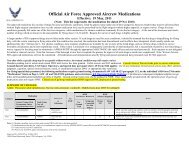

![Body Composition and Military [PDF] - Human Performance ...](https://img.yumpu.com/43269347/1/190x245/body-composition-and-military-pdf-human-performance-.jpg?quality=85)
![Tips for Grocery Shopping [PDF]](https://img.yumpu.com/37447379/1/190x245/tips-for-grocery-shopping-pdf.jpg?quality=85)
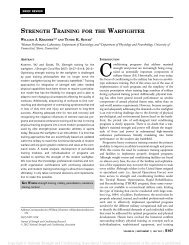
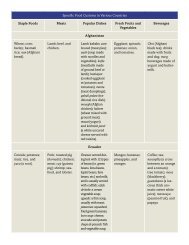
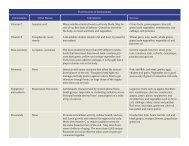
![Synthetic Drugs [PDF] - Human Performance Resource Center](https://img.yumpu.com/37447322/1/190x245/synthetic-drugs-pdf-human-performance-resource-center.jpg?quality=85)
